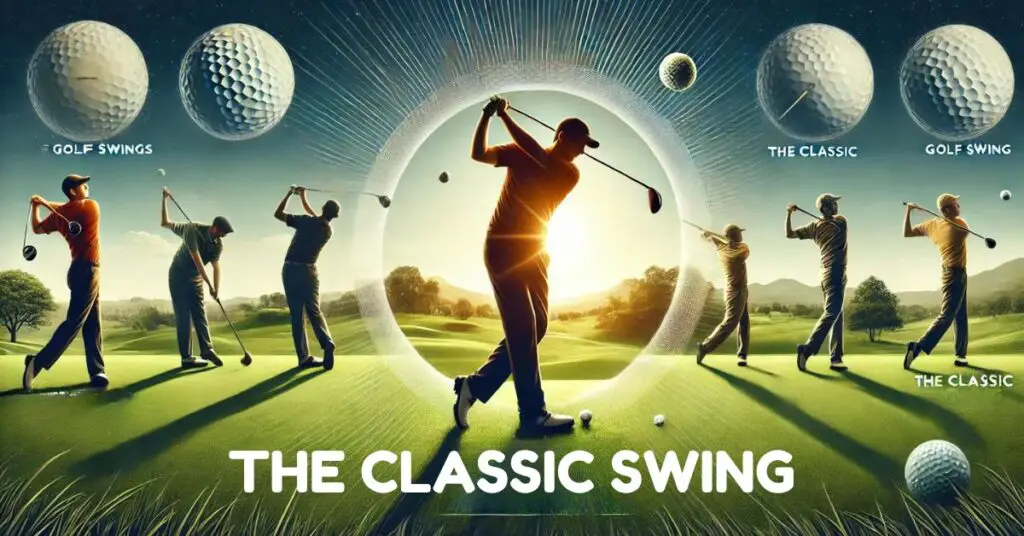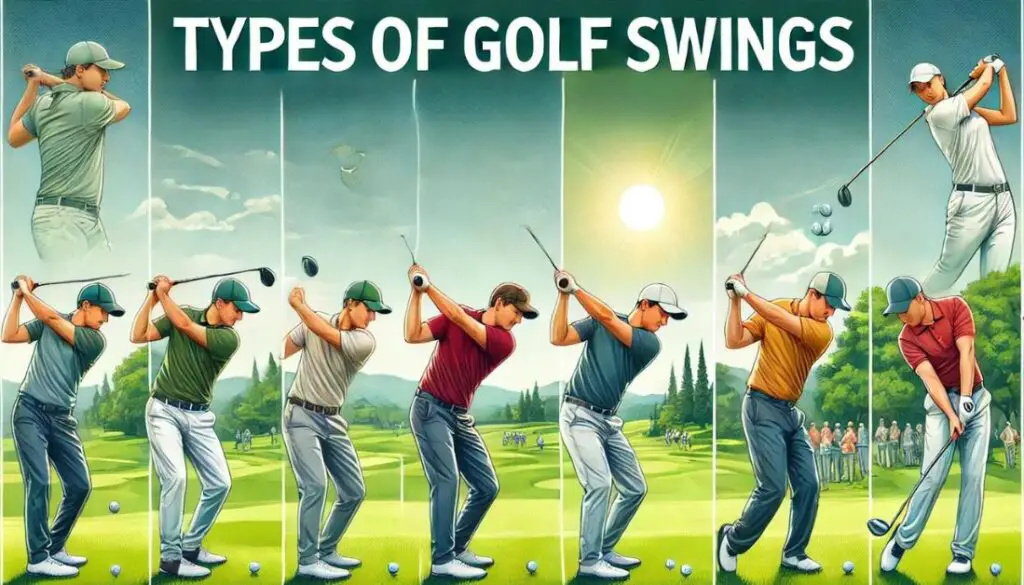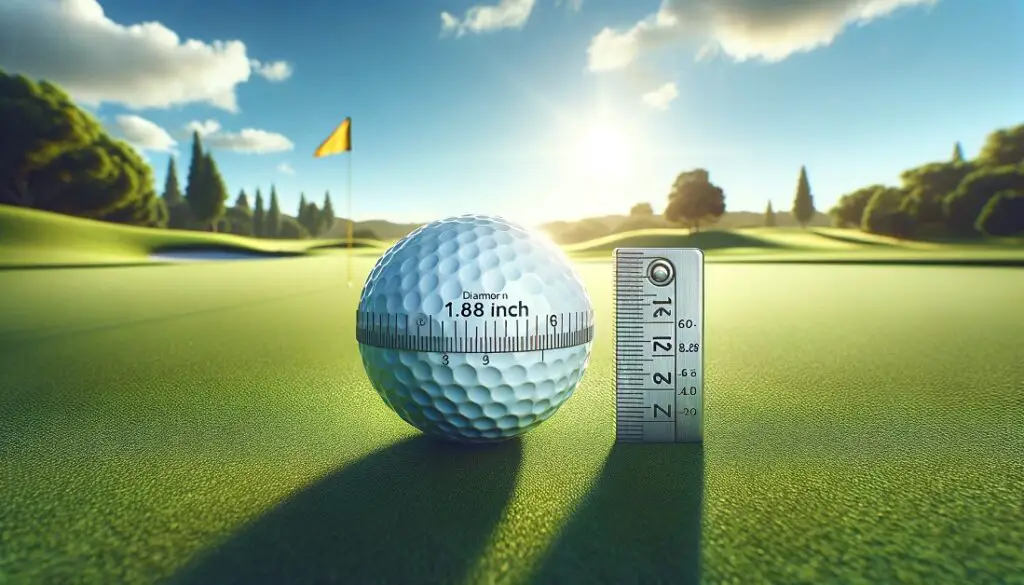Finding a good golf swing can feel like searching for a needle in a haystack. With over 40 million golfers in the United States alone, many are frustrated by the inconsistency and lack of accuracy in their game. You might be one of them, standing on the course, wondering why your shots veer off target despite countless hours of practice.
Understanding the different types of golf swings isn’t just for pros—it’s the key to unlocking your potential and improving your accuracy. Whether you’re a seasoned, struggling with your current technique, or just curious about other styles, this guide will demystify the swings and help you find the one that fits you best.
Table of Contents
ToggleDifferent Types Of Golf Swings
Understanding the various types of swings in golf can significantly impact your game. Each swing has its unique characteristics, advantages, and techniques, tailored to different player styles and needs. Let’s explore the most notable ones.
The Classic Swing

The Classic Swing is often considered the foundation of golf. It’s a traditionalist, well-balanced technique that depends on a complete shoulder turn, appropriate weight transfer, and efficient follow-through. During the backswing, the golfer smoothly brings the club back, ensuring a full extension of the arms and a rotation of the upper body to set up for the downswing.
Due to its reputation for dependability and regularity, the Classic Swing is a favorite move among players, particularly those who value the game’s classic aspects. It is a rotating movement in which the hands and arms carry the golf club along the swing path while the hips and shoulders cooperate to produce power.
Pros
- Consistent and reliable: Offers a repeatable motion that builds muscle memory.
- Good balance between power and control: Provides an optimal mix for various shot types.
- Widely taught and understood: Easy to find resources and instruction.
- Suitable for a variety of shot types: Versatile across different course scenarios.
Cons
- Requires good timing and coordination: Demands precise movement synchronization.
- Can be challenging for beginners to master: Steeper learning curve.
- May not maximize distance: Often prioritizes control over raw power.
Single Plane Swing
The One Plane Swing simplifies the mechanics by keeping the golf club on one plane from start to finish. Golfers like Moe Norman have made this approach popular. Its goal is to make your swing easier to repeat consistently by minimizing its moving parts. This swing can increase accuracy and golf ball hitting by bringing the arms and club into alignment on a single plane at address, reducing the possibility of mistakes.
Pros
- Simplified mechanics: Easier to learn and replicate.
- Easier to repeat consistently: Reduces variability in the swing.
- Reduces the risk of errors: Fewer moving parts lead to fewer mistakes.
- Can improve accuracy: Focuses on precise ball contact.
Cons
- May feel unnatural for some players: Requires adjustment to new mechanics.
- Can limit the flexibility of shot-making: Less adaptable to different shots.
- Less focus on generating power: Prioritizes accuracy over distance.
The Power Swing

For golfers looking to maximize distance, the Power Swing is the go-to technique. This swing emphasizes explosive power generated from a strong hip turn and aggressive weight shift. Golfers who adopt the Power Swing often have a more aggressive stance and take a wider backswing. The key to a successful Power Swing is building strength and flexibility, allowing for a rapid, forceful rotation. While it might sacrifice some accuracy, the Power Swing is perfect for players who need extra yards off the tee.
Pros
- Maximizes distance: Ideal for long drives and par 5 holes.
- Utilizes strong lower body movements: Engages core muscles for power.
- Ideal for long drives: Achieves impressive shot distances.
- It can be impressive to watch: Adds a dynamic element to your game.
Cons
- Requires excellent physical conditioning: Demands strength and fitness.
- Can sacrifice accuracy for power: Harder to control consistently.
- More prone to mishits and errors: Increased risk of off-center strikes.
- Demands good control and timing: Precision is crucial for success.
Rotational Based Swing
The Rotational Based Swing focuses on the efficient use of body rotation to generate power and control. In contrast to swings that primarily use arm movement, this swing method rotates the torso using the core muscles, keeping the lower body stable. By reducing the tension on the arms and shoulders, this technique encourages a longer-lasting swing for playing. For golfers who want to increase their power without sacrificing control, the rotational based swing is perfect.
Pros
- Generates smooth and consistent swings: Fluid motion enhances reliability.
- Reduces strain on arms and hands: Lowers the risk of repetitive stress injuries.
- Improves ball control: Enhances accuracy and precision.
- Efficient power transfer: Maximizes energy use from the core.
Cons
- Requires good flexibility and coordination: Demands physical agility.
- Can be difficult for beginners to learn: Steeper initial learning curve.
- Less focus on arm and hand control: Shifts emphasis away from fine-tuning.
Also Explore: Rotate Your Body Like A Pro And Improve Your Golf Swing
Hands And Arms-Based Swing

The Hands and Arms-Based Swing, as its name suggests, gives priority to hand and arm movement higher than body rotation. This swing style is frequently used by players who like a more hands-on approach, where the clubface and ball trajectory are mainly controlled with the hands. It may not produce as much force as rotational swings, but it is easier for beginners to learn and produces accuracy.
Pros
- Easier for beginners to learn: Simplifies initial swing mechanics.
- Greater control over the club: Enhances precision for short shots.
- Effective for short shots and precision play: Ideal for approaches and putts.
- Less reliance on body mechanics: Reduces physical demands.
Cons
- Generates less power compared to rotational swings: Limits driving distance.
- This can lead to inconsistencies in longer shots: Which harder to maintain over full swings.
- More strain on hands and arms: Increases risk of fatigue and injury.
- Limited overall distance: Not ideal for power players.
Separation Based Swing
The Separation Based Swing, or X-Factor Swing, focuses on creating a differential between the hips and shoulders. This technique creates a “coil” effect, storing potential energy that is released explosively at impact. By maintaining a stable lower body and allowing the upper body to rotate independently, golfers can achieve a powerful and efficient swing. This swing method requires good flexibility and timing but can lead to impressive power and distance.
Pros
- Significantly boosts distance: Adds yardage to your shots.
- Efficient energy transfer: Optimizes power generation.
- Can enhance power without sacrificing accuracy: Balances strength and control.
- Creates a powerful lag effect: Increases clubhead speed.
Cons
- Requires flexibility and coordination: Demands physical readiness.
- Can be challenging to master: Takes time to perfect the timing.
- Puts strain on the lower back: Increased risk of injury.
- This may lead to timing issues: Precision is critical for consistency.
Stack And Tilt

The Stack and Tilt Swing is a modern approach that changes the traditional weight shift dynamic. Instead of shifting weight back and forth, players keep their weight forward throughout the swing. This method encourages a downward strike on the ball, which can lead to more consistent and stronger contact. Players who have trouble with fat or thin shots will benefit most from the stack and tilt swing because it creates a more straight path to the ball.
Pros
- Promotes consistent ball striking: Reduces mishits and fat shots.
- Reduces the risk of fat shots: Ensures clean contact.
- Improves accuracy and control: Enhances shot precision.
- Can reduce back pain: Less strain on the spine.
Cons
- Unconventional approach: May feel unusual initially.
- May feel awkward initially: Requires adaptation.
- Limits flexibility in shot types: Less versatile for varied shots.
- Requires practice to master: Consistent application is necessary.
Hold Off Swing
The Hold Off Swing is a technique used to control the ball flight, particularly useful for reducing hooks and slices. In this swing, the golfer deliberately delays the release of the wrists, keeping the clubface square through impact for a more controlled shot. This method is beneficial for players seeking to enhance their accuracy and manage their ball trajectory, making it a versatile addition to any golfer’s arsenal.
Pros
- Excellent for controlling ball flight: Ideal for accuracy.
- Reduces hooks and slices: Keeps shots straighter.
- Offers better directional control: Enhances precision.
- Useful in challenging conditions: Effective in windy situations.
Cons
- Can limit distance: Sacrifices power for control.
- Requires precise timing: Demands consistent technique.
- Less natural for some players: May feel restrictive.
- Demands consistent practice: Needs regular refinement.
Every one of these swings has its own advantages and matches different playing styles and goals. Gaining an understanding and experience with these golf swing methods, much like those taught by PGA professionals, can assist you in determining which swing best fits your style of play, which will enhance your accuracy and overall performance.
Also Explore: Wedge Swing vs Iron Swing Learn The Secrets
Also Explore: Perfect Your Slow Motion Golf Swing For Maximum Control
Which Type Of Swing Is Best For You

A range of factors, like as your skill level, goals as a golfer, and physical condition, will determine which golf swing types is best for you. Here’s a guide to help you choose which swing could be most appropriate for you.
1. Assess Your Physical Condition
- Flexibility: A Separation Based Swing (X-Factor Swing) or a Rotational-Based Swing might help you generate power efficiently if you have good flexibility.
- Strength: The Power Swing may be your best option for maximizing distance if you have a strong lower body and good physical conditioning.
- Injuries: The Stack and Tilt Swing can help minimize strain and encourage constant contact if you have back pain or other problems.
2. Evaluate Your Skill Level
- Beginners: If you’re new to golf, start with a Hands and Arms Swing or the Single Plane Swing. These are easier to learn and emphasize control, helping you build confidence.
- Intermediate Players: The Classic Golf Swing is a fantastic all-around choice for players who want to improve their technique since it strikes a nice mix of power and control.
- Advanced Players: The Separation Based Swing, which demands exact time and coordination but produces amazing power and distance, may be advantageous for experienced golfers.
3. Consider Your Goals
- Accuracy: If your primary goal is to improve accuracy and reduce errors, the Hold Off Swing is ideal. It helps control ball flight and minimizes hooks and slices.
- Consistency: For consistent performance across different shot types, the Classic Swing or the Stack and Tilt Swing can be beneficial. They promote reliable and repeatable motions.
- Power: If your main focus is on driving the ball long distances, consider the Power Swing or the Separation Based Swing. These techniques are designed to maximize power and distance.
4. Try And Adapt
- Experiment: Don’t be scared to try out different golf swings types. It’s possible that what suits one player won’t suit another. At the range, experiment with various methods to see which is most efficient and comfortable.
- Get Professional Advice: Think about investing in professional golf coaching. They are able to evaluate your swing and suggest modifications or a swing type that best fits your physique and playing style.
- Listen to Your Body: Observe your body’s reaction to different swings in golf. A swing technique isn’t appropriate for you if it causes any discomfort.
5. Blend Techniques
- Customization: Sometimes the best swing for you might be a hybrid of different techniques. For example, combining elements of the Rotational Based Swing with the Single Plane Swing could offer a unique balance that fits your style.
Also Explore: How Can We Do Same Golf Swing With Different Club
Conclusion
It’s all about understanding your body, your ability level, and your goals when it comes to finding the right types of golf swings. From the Power Swing to the Classic Swing, each style of swing has its own advantages and difficulties. The secret is to figure out what works best for you by trying different things and maybe consulting an expert.
First, think about your physical condition, including your strength, flexibility, and any potential injuries. Particularly if you’re a beginner, match your skill level to the swing that’s the simplest to learn and control. Consider your goals, such as increasing power, accuracy, or consistency. Don’t be afraid to combine different strategies to make a swing that is uniquely yours.
Remember that your best swing is one that comes easily to you and increases your enjoyment of the game as you improve your skill level. Discovering your ideal swing will boost the happiness and satisfaction you derive from your time on the golf course, even if it takes some time and effort.
FAQ's
The golf swing has developed over centuries and is not credited to a single creator. Scottish golfers created the earliest versions of the swing in the 15th century. Over the years, several golfers and teachers have inspired modern tactics and styles.
While there are many different types of golf swings, the Classic, Single Plane, Power, Rotational, Hands and Arms, Separation, Stack and Tilt, and Hold Off swings are the most popular ones.
No, there isn’t a particular swing style that every golfer should use. The best swing type varies depending on a person’s skill level, physical condition, and personal preferences.



